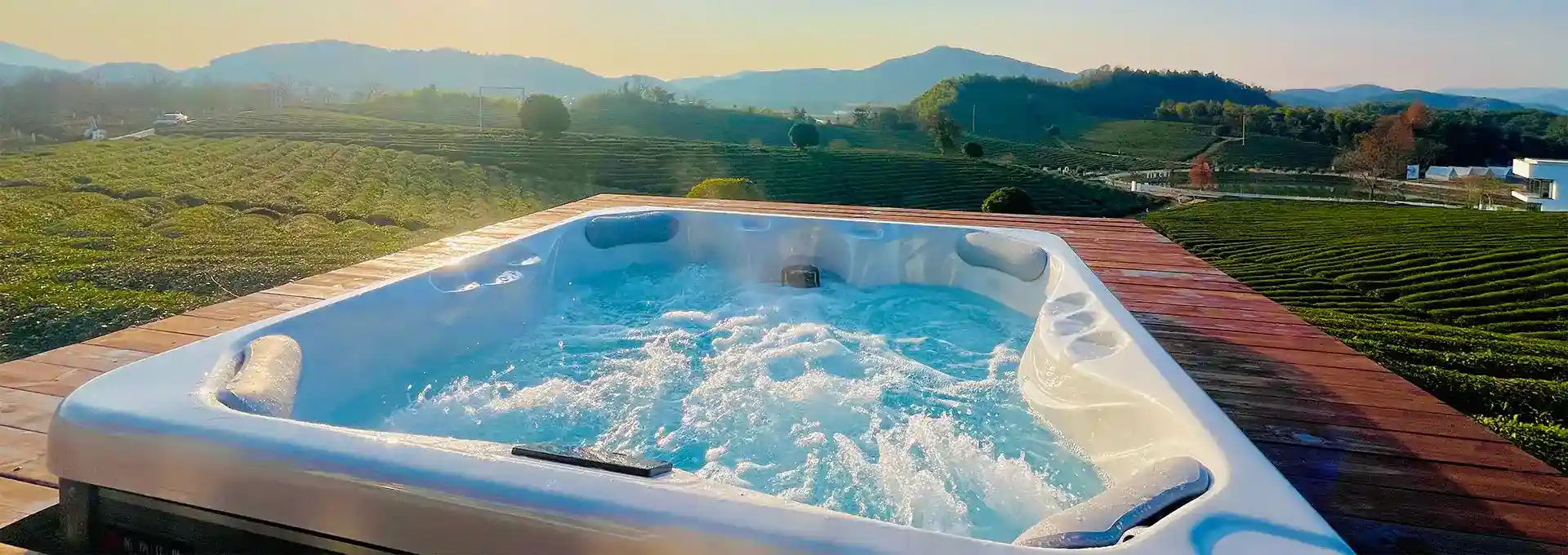How to Run a Swim Spa Power Connector?
2024-12-19 16:57:31
Running a swim spa power connector is a crucial step in setting up and maintaining your swim spa. This process involves properly connecting the electrical supply to your swim spa, ensuring safety, and optimizing performance. Understanding the correct procedures and precautions is essential for anyone looking to install or upgrade their swim spa's power connection. In this comprehensive guide, we'll explore the key aspects of running a swim spa power connector, including important considerations, step-by-step instructions, and safety measures.
What are the electrical requirements for a swim spa?
Before diving into the installation process, it's crucial to understand the electrical requirements for a swim spa. Swim spas typically require a dedicated electrical circuit due to their high power demands. The specific requirements can vary depending on the model and size of your swim spa, but generally, they fall into the following categories:
- Voltage: Most swim spas operate on 220-240 volts, which is a higher voltage than standard household circuits. This higher voltage is necessary to power the pumps, heaters, and other components efficiently.
- Amperage: The amperage requirements can range from 30 to 60 amps or more, depending on the swim spa's features and size. Larger swim spas with multiple pumps and heaters may require up to 100 amps.
- Circuit Breaker: A dedicated circuit breaker is essential for the swim spa. The size of the breaker should match the amperage requirements of your specific model.
- Wiring: The wire gauge used must be appropriate for the amperage of the circuit. Typically, 6 AWG (American Wire Gauge) copper wire is used for 50-amp circuits, while 8 AWG is suitable for 40-amp circuits.
- Ground Fault Circuit Interrupter (GFCI): A GFCI is a crucial safety device that quickly breaks the circuit if it detects a ground fault. This is mandatory for swim spa installations to prevent electrical shock hazards.
It's important to consult your swim spa's user manual or contact the manufacturer to determine the exact electrical requirements for your specific model. Additionally, local building codes and regulations may have specific requirements for swim spa installations, so it's advisable to check with your local authorities or a licensed electrician familiar with these regulations.
When planning your swim spa installation, consider the location of your electrical panel and the distance to the swim spa. Longer distances may require larger gauge wiring to compensate for voltage drop. It's also crucial to ensure that your home's electrical service can handle the additional load of a swim spa. In some cases, you may need to upgrade your electrical panel or service to accommodate the swim spa's power requirements.
Understanding these electrical requirements is the first step in ensuring a safe and efficient power connection for your swim spa. With this knowledge, you can better plan the installation process and communicate effectively with professionals who will assist in the setup.
How do you wire a swim spa for power?
Wiring a swim spa for power is a complex task that requires careful planning and execution. While it's strongly recommended to hire a licensed electrician for this job due to the high voltage involved and the need for compliance with local codes, understanding the process can help you make informed decisions and ensure the installation is done correctly.
Here's a general overview of the steps involved in wiring a swim spa for power:
- Plan the Route: Determine the best path for running the electrical conduit from your home's main electrical panel to the swim spa location. Consider obstacles, underground utilities, and the most direct route possible.
- Install the Conduit: Lay the appropriate size of electrical conduit along the planned route. This conduit protects the wires and meets most local code requirements for outdoor wiring.
- Run the Wires: Pull the correct gauge wires through the conduit. This typically includes two hot wires, a neutral wire, and a ground wire. The wire size depends on the amperage required by your swim spa and the distance from the main panel.
- Install the Disconnect Box: A disconnect box is required near the swim spa. This allows for quick power cut-off in case of emergencies and during maintenance. The box should be easily accessible but not too close to the spa to avoid accidental contact while in use.
- Connect the GFCI Breaker: Install a GFCI breaker in the main electrical panel. This device is crucial for safety, as it quickly cuts power if it detects a ground fault.
- Wire the Swim Spa Control Box: Connect the wires from the disconnect box to the swim spa's control box. This usually involves removing a panel on the spa to access the control box.
- Ground the System: Proper grounding is essential for safety. Connect the ground wire to the grounding bar in the disconnect box and ensure it's properly bonded to the swim spa's metal components.
- Verify Connections: Double-check all connections to ensure they are tight and secure. Loose connections can cause overheating and electrical failures.
- Test the Circuit: Before finalizing the installation, test the circuit to ensure everything is working correctly. This includes checking the GFCI functionality and verifying that all spa components are receiving power.
- Seal and Weatherproof: Properly seal all connections and ensure that outdoor components are weatherproofed to protect against moisture and environmental factors.
It's crucial to emphasize that working with high-voltage electricity is dangerous and should only be done by qualified professionals. Improper wiring can lead to serious safety hazards, including fire risks and electrical shock. Additionally, many jurisdictions require that electrical work for swim spas be performed by licensed electricians and inspected by local authorities before use.
When hiring an electrician for this task, ensure they have experience with swim spa installations and are familiar with local codes and regulations. They should provide a detailed plan of the installation, including the materials to be used and any necessary upgrades to your existing electrical system.
Remember that the specific wiring details may vary depending on your swim spa model and local electrical codes. Always refer to the manufacturer's instructions and consult with local building authorities to ensure compliance with all relevant regulations.
What safety precautions should be taken when connecting a swim spa power supply?
Connecting a swim spa power supply requires strict adherence to safety precautions due to the high voltage involved and the unique environment where the spa is typically installed. These safety measures are crucial not only during the installation process but also for the long-term safe operation of your swim spa. Here are the key safety precautions that should be taken:
- Hire a Licensed Electrician: This is the most important safety precaution. A licensed and experienced electrician will ensure that the installation meets all safety standards and local electrical codes. They have the knowledge to handle high-voltage systems safely and can identify potential hazards that may not be apparent to non-professionals.
- Use Proper Equipment and Materials: All electrical components, including wires, conduits, breakers, and disconnects, should be rated for outdoor use and suitable for the specific amperage and voltage requirements of your swim spa. Using substandard or incorrect materials can lead to electrical failures and safety hazards.
- Install a GFCI (Ground Fault Circuit Interrupter): This is a critical safety device that detects ground faults and quickly cuts off power to prevent electrical shock. Ensure that the GFCI is properly sized for your swim spa's electrical requirements and is installed correctly.
- Proper Grounding and Bonding: All metal components of the swim spa and surrounding area should be properly grounded and bonded. This includes the spa shell, pumps, heaters, and any nearby metal objects. Proper grounding helps prevent electrical shock and reduces the risk of stray voltage.
- Install a Disconnect Switch: A visible and easily accessible disconnect switch should be installed near the swim spa. This allows for quick power cut-off in emergencies or during maintenance. The switch should be located at least 5 feet away from the spa to prevent accidental operation while in use.
- Weatherproof Connections: All outdoor electrical connections should be properly sealed and weatherproofed to protect against moisture, which can cause short circuits or corrosion. Use appropriate weatherproof boxes and sealing methods.
- Follow Manufacturer's Instructions: Adhere strictly to the manufacturer's guidelines for electrical installation. These instructions are specific to your swim spa model and take into account its unique features and requirements.
- Maintain Proper Clearances: Ensure that electrical components are installed with proper clearances from water sources and other hazards. This includes keeping electrical equipment away from areas prone to flooding or water splashing.
- Regular Inspections: After installation, schedule regular inspections of the electrical system. Look for signs of wear, corrosion, or damage, especially in outdoor components exposed to the elements.
- Education and Awareness: Educate all users of the swim spa about electrical safety. This includes knowing the location of the disconnect switch and understanding basic electrical safety around water.
- Avoid DIY Repairs: Never attempt to repair or modify the swim spa's electrical system yourself. Always call a qualified electrician for any electrical issues or modifications.
- Comply with Local Codes: Ensure that the installation complies with all local building and electrical codes. These codes often have specific requirements for outdoor electrical installations and may require permits or inspections.
- Consider Environmental Factors: Take into account environmental factors such as flooding potential, extreme weather conditions, and wildlife that could potentially damage electrical components.
- Use Appropriate Personal Protective Equipment (PPE): During installation or maintenance, ensure that proper PPE is used, including insulated gloves and tools rated for electrical work.
- Emergency Planning: Have an emergency plan in place. This should include knowing how to quickly cut power to the spa and having emergency contact numbers readily available.
By following these safety precautions, you can significantly reduce the risks associated with connecting and operating a swim spa power supply. Remember, the combination of electricity and water creates a potentially hazardous environment, making it crucial to prioritize safety at every step of the installation and operation process.
It's also important to maintain these safety measures over time. Regularly check the GFCI functionality, inspect visible wiring and connections for signs of wear or damage, and keep the area around electrical components clear and dry. If you notice any unusual behavior in your swim spa's electrical system, such as tripping breakers or fluctuating power, immediately discontinue use and contact a professional electrician.
Lastly, stay informed about any updates or recalls related to your swim spa model or its electrical components. Manufacturers occasionally issue safety notices or updates that may be relevant to your installation.
For more information on hot tub installations and to find out more about our products, please feel free to contact us at info@iparnassus.com.
References
- National Electrical Code (NEC) - Article 680: Swimming Pools, Fountains, and Similar Installations
- Consumer Product Safety Commission - Safety Barrier Guidelines for Residential Pools
- Swim Spa Manufacturer's Installation Guides (e.g., Master Spas, Endless Pools)
- American Red Cross - Home Pool Safety
- Electrical Safety Foundation International (ESFI) - Outdoor Electrical Safety
- U.S. Department of Energy - Home Electrical Safety
- International Association of Certified Home Inspectors (InterNACHI) - Spa and Hot Tub Inspection
- Occupational Safety and Health Administration (OSHA) - Electrical Safety Guidelines
- Pool & Hot Tub Alliance (PHTA) - Safety and Maintenance Guidelines
- Local Building and Electrical Codes (specific to your area)



